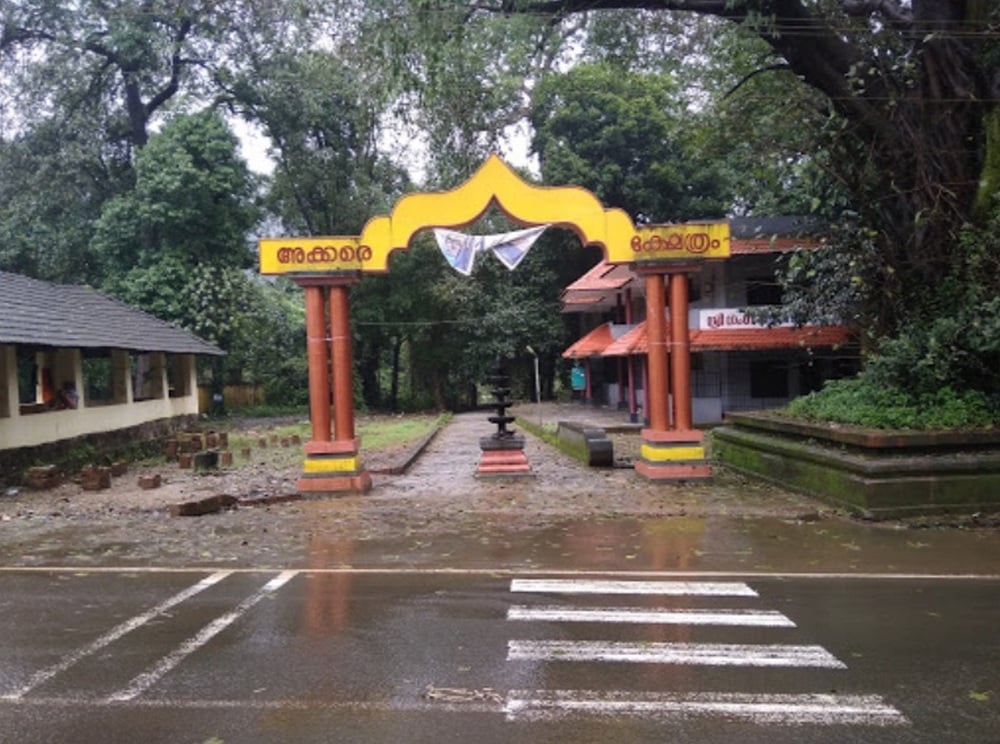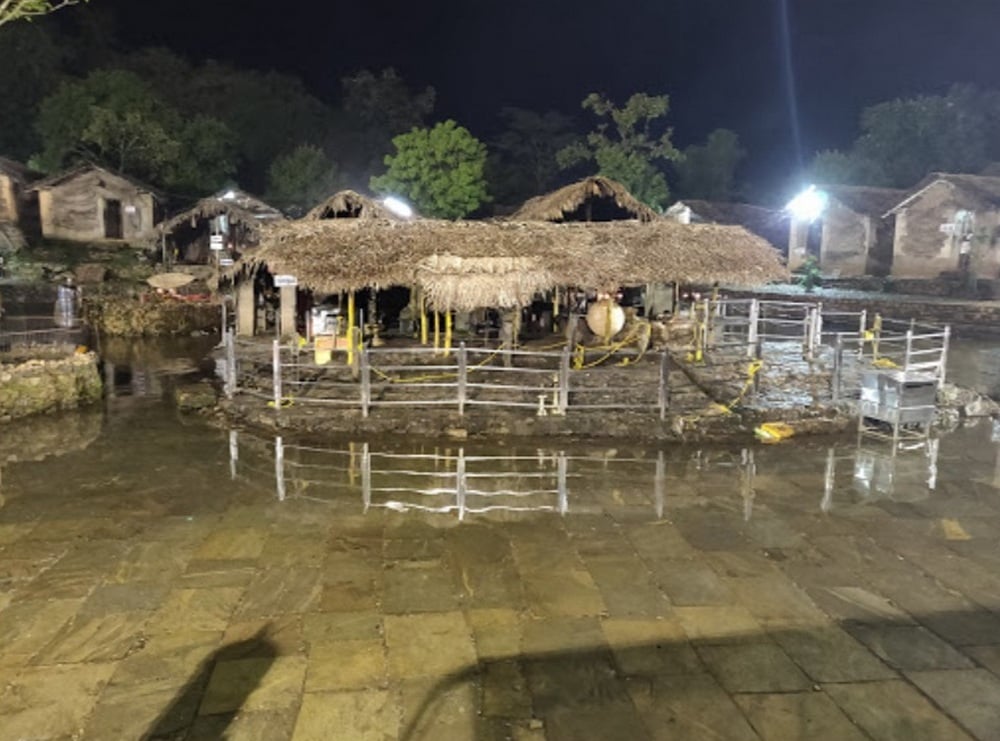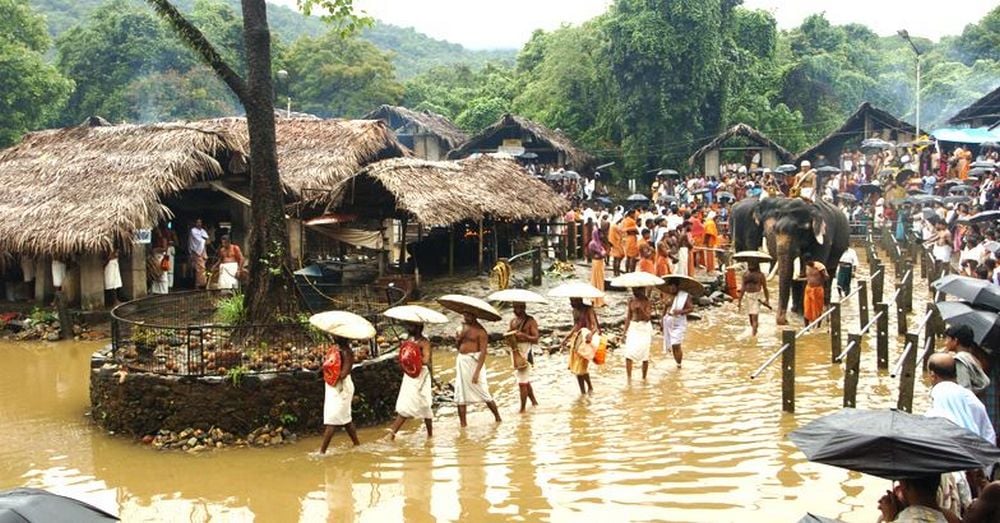Kottiyoor Temple is a prominent Shiva temple located in Kottiyoor, Kannur, Kerala, India.

It was historically under the rule of the Kattan dynasty of Puralimala, from which the name 'Katti-yoor' originated, later evolving into 'Kottiyoor' in the local dialect. Traditionally known as Vadakkeshwaram Temple, it is also referred to as Ikkare Kottiyoor by locals to distinguish it from the temporary shrine on the opposite bank of the Baveli (Vavali) River.
Another name associated with the temple is Thruchherumana Kshetram. It is a special category temple under the Malabar Devaswom Board. The Kottiyoor temple complex comprises two shrines: one on the western bank of the river, Vadakkeshwaram or Ikkare Kottiyoor, which is a permanent structure, and the other on the eastern bank, known as Kizhakkeshwaram or Akkare Kottiyoor, a temporary hermitage that opens only during the annual Kottiyoor Vysakha Mahotsavam.
The temple is nestled within a sacred grove spanning approximately 80 acres of dense forest. According to legend, Akkare Kottiyoor is the site of the mythical Daksha Yaga, where Sati Devi immolated herself, making it a place of great spiritual significance. Kottiyoor Perumal Temple, once among the richest temples in Kerala, was second only to the famed Padmanabhaswamy Temple in terms of its collection of gold and precious stones. While the Padmanabhaswamy Temple is globally recognized as the wealthiest place of worship, Kottiyoor Perumal's immense wealth—consisting of priceless ornaments and jewels—was traditionally safeguarded in the ‘Karimbana Gopuram’ of the Ikkare Kottiyoor Temple.
Additionally, the temple historically held ownership over more than 30,000 acres of forest land in Kannur district. The Thruchherumana Temple, part of the Kottiyoor temple complex, was constructed following the discovery of a Swayambhoo (self-manifested) Shiva Lingam. Though the precise date of the temple's origin remains unknown, the pilgrimage to this sacred site has been ongoing for many centuries, reflecting its deep spiritual and historical significance.
Kottiyoor Temple is deeply revered across Kerala and neighboring regions, held in high spiritual esteem due to its association with profound legends and divine presence. According to tradition, the shrine is sanctified by the presence of the Holy Trinity—Brahma, Vishnu, and Shiva—along with the primordial Mother Goddess, Bhagavathy. Because of this sacred convergence, Kali, the embodiment of the Kali Yuga, is believed to have pledged to Parashurama in the presence of the Trimurthy that he would not enter the premises of this holy shrine.
Kottiyoor is considered one of the most sacred Shakti shrines in India and holds a unique place among the few temples dedicated to Sati Devi. In adherence to ancient religious principles, no permanent structures are built at the eastern shrine (Akkare Kottiyoor); instead, simple, temporary structures resembling sage hermitages are erected. There is no sanctum sanctorum here—Sati is worshipped as Shakti at the ‘Ammarakkalu Thara’, a raised platform beside the Swayambhoo Linga, believed to be the exact spot where Sati Devi immolated herself during the Daksha Yaga.
This site is also regarded as the origin point of the Shakti Peethas.
The name "Kottiyoor" is believed to be derived from the words Koodi (meeting) and Uuru (place), symbolizing the divine gathering of deities. The temple is notable for its ancient, unaltered architecture, intentionally preserved to maintain its sacred customs and time-honored traditions.
Kottiyoor Pilgrimage is a significant cultural and spiritual event marked by widespread participation from diverse sections of society. Hindu communities from across the region walk for over a hundred kilometers to bring raw materials to the temple as part of an age-old ritual. These duties were originally assigned by the Kottayam (Pazhassi) royal family to specific communities, and they have been faithfully upheld without change since their inception. Each community regards its role as both a sacred duty and a hereditary right, and this enduring tradition has been woven into the fabric of their cultural identity for centuries.
The temple, nestled in a tranquil and dense forest that has now been declared a Wildlife Sanctuary by the Government of Kerala, provides a serene backdrop to this deeply spiritual event. The rituals performed during the Kottiyoor festival exemplify communal harmony among the Shaiva, Vaishnava, and Shakteya traditions. A highlight of the Vysakha Mahotsavam is the Rohini Aradhana, a revered ritual where the head of the Vaishnavite Kurumathoor family performs the Aalingana Pushpanjali (flower offering in an embracing gesture) to the Swayambhoo Linga.
This act symbolizes Lord Vishnu embracing Lord Shiva to console him after the tragic loss of his beloved consort, Sati Devi, underscoring the deep emotional and theological significance of the festival. The prathishta, or installation, of the Thruchherumana Temple (also known as the Ikkare Kottiyoor Temple) is believed to have been performed by Parashurama on the western bank of the river. This temple is dedicated to the year-round worship of Lord Shiva, unlike the Swayambhu linga located across the river, which is accessible for worship only during the 27 days of the annual Vysakha Mahotsavam.
Adi Sankaracharya is credited with codifying the temple’s rites and rituals. During his visit, he offered prayers at the Thruchherumana Temple but chose not to cross the river to the Swayambhu linga, as it was not the designated pilgrimage period. According to tradition, Sankaracharya recognized the Swayambhu linga as a universal symbol of Shiva, eternally in union with Nature, or Devi. It is believed that in this state, Lord Shiva desires complete solitude and grants blessings only during the Vysakha Mahotsavam.
This belief continues to this day, with visits to the Swayambhu linga or Akkare Kottiyoor restricted outside the pilgrimage season.
During his visit, Sankaracharya bathed in the Vavali River, offered prayers from the western bank, and then resumed his spiritual journey. The Vaisakha Maholsavam is an annual festival held during the months of May and June. This 28-day celebration begins with the 'Neyyattam' ritual on the Chodi day in the Malayalam month of Edavam (Rishabham) and concludes with the 'Thrikkalashaattu' ceremony. The festival opens with the arrival of a ceremonial sword from Muthirerikavu in Wayanad, signifying the start of the sacred events.
On the following day, under the Visakham star, the ‘Bhandaram Ezhunnallathu’ takes place, during which ornaments and pooja vessels made of pure gold and silver are brought from Manathana village to Kottiyoor.
One of the most significant rituals is the 'Elaneer Vayppu', where thousands of devotees offer tender coconuts at the site of the Swayambhu Shiva Linga. The next day, temple Namboothiris extract the water from these coconuts into golden and silver vessels, and the Chief Priest performs the ‘Elaneeraattam’—also known as ‘Rashi Velli’—by pouring the sacred coconut water over the Shiva Linga.
Another unique ritual of the festival is the 'Rohini Aaradhana', found exclusively at Kottiyoor. In this ritual, the Kurumathur Brahman, regarded as the symbolic embodiment of Lord Vishnu, embraces the Swayambhu Shiva Linga. This act represents Vishnu consoling Shiva in his grief over the loss of his consort, Sati. As part of the Vaisakha Maholsavam festival at Kottiyoor, a grand procession (Ezhunnallippu) is held in which two elephants carry the idols of Lord Shiva and Goddess Parvathi. Following the procession, a ceremonial elephant feeding ritual known as "Aanayootu" is conducted, after which the elephants are given a formal and respectful farewell.
Traditionally, the 'Thammangadan Nambiar' family (also known as the Vediyara Chandrothu family), a sub-branch of the Thiruvithamkur/Kolathiri Royal Family, holds the exclusive right to be the first to offer ghee for the Abhishekam (ritual bathing) of the deity during the "Naallam Thurakkal" ritual. This honor is rooted in long-standing custom and is carried out at the Kottiyoor Shiva Temple, which is believed to be the sacred site of Daksha's legendary Yajna. The member of this family who performs the ghee-offering ritual is referred to as "Villippalan Kurup."
കൊട്ടിയൂർ ശിവക്ഷേത്രം
വടക്കേ മലബാറിലെ പ്രശസ്തമായ മഹാദേവക്ഷേത്രങ്ങളിൽ പ്രധാനപ്പെട്ടവയാണ് കൊട്ടിയൂർ ശിവക്ഷേത്രങ്ങൾ. ഇവ കണ്ണൂർ ജില്ലയിലെ കൊട്ടിയൂർ ഗ്രാമത്തിലാണ് സ്ഥിതിചെയ്യുന്നത്. ബാവലിപ്പുഴയുടെ കരയിൽ സ്ഥിതിചെയ്യുന്ന ഈ പ്രദേശം “ദക്ഷിണ കാശി” എന്നറിയപ്പെടുന്നു. ഇവിടം “ഇക്കരെ കൊട്ടിയൂർ” ക്ഷേത്രവും “അക്കരെ കൊട്ടിയൂർ” ക്ഷേത്രവും ചേർന്ന് രണ്ടു ഭാഗങ്ങളിലായി നിലകൊള്ളുന്നു.
അക്കരെ കൊട്ടിയൂർ ക്ഷേത്രത്തിലെ ശിവലിംഗം സ്വയംഭൂവാണെന്ന് വിശ്വസിക്കുന്നു. പാൽ, നെയ്യ്, ഇളനീർ എന്നിവ ഉപയോഗിച്ചാണ് അഭിഷേകം നടത്തുന്നത്.
തിരുവഞ്ചിറ എന്ന് വിളിക്കുന്ന വലിയ തടാകത്തിന്റെ മദ്ധ്യഭാഗത്തെ മണിത്തറയിലാണ് ഈ ശിവലിംഗം പ്രതിഷ്ഠിതമായിരിക്കുന്നത്. ഈ തടാകത്തിലുണ്ടായ മറ്റൊരു തറയായ “അമ്മാറക്കല്ല്” എന്ന സ്ഥലത്താണ് ആദിപരാശക്തിയായ ശ്രീപാർവതീദേവിയെ ആരാധിക്കുന്നത്. തുമ്പ, തുളസി, കൂവളം ഇത്തരത്തിലുള്ള പുഷ്പങ്ങളാണ് മണിത്തറയിൽ ഉപയോഗിക്കുന്നത്. ഭക്തർക്ക് പ്രസാദവും അന്നദാനവും നൽകുന്നത് മലവാഴയുടെ ഇലയിലാണ്. പ്രധാന ആഘോഷമായ നീരെഴുന്നള്ളത്തിന് വേണ്ട ജലം കാട്ടുകൂവയുടെ ഇലയിലാണ് കൊണ്ടുപോകുന്നത്.
അക്കരെ കൊട്ടിയൂർ ക്ഷേത്രത്തിൽ പ്രതിവർഷം ഇടവ മാസത്തിലെ ചോതി നക്ഷത്രത്തിൽ ആരംഭിച്ച് മിഥുന മാസത്തിലെ ചിത്തിര നക്ഷത്രത്തിൽ സമാപിക്കുന്ന 27 ദിവസത്തെ വൈശാഖ മഹോത്സവം ആചരിക്കപ്പെടുന്നു. ഈ ഉത്സവത്തിന് ഏറെ വൈശിഷ്ട്യവും ഭക്തിസാന്ദ്രതയുമുണ്ട്. കർണ്ണാടക, തമിഴ്നാട്, ആന്ധ്രപ്രദേശ് തുടങ്ങിയ സംസ്ഥാനങ്ങളിലെയും ഉത്തര മലബാറിലെ വിവിധ ഭാഗങ്ങളിലെയും ആയിരക്കണക്കിന് തീർത്ഥാടകർ ഈ മഹോത്സവ ദിനങ്ങളിൽ കൊട്ടിയൂരിലെത്തുന്നു.വയനാട് ചുരങ്ങളിലൂടെ ഒഴുകിവരുന്ന ബാവലി പുഴയുടെ വടക്കേ കരയിലാണ് തിരുവഞ്ചിറ എന്നറിയപ്പെടുന്ന പുഴയുടെ നടുവിൽ കൊട്ടിയൂരിലെ പ്രധാന ആരാധനാ കേന്ദ്രമായ സ്വയംഭൂ ശിവലിംഗവും പരാശക്തിയുടെ സ്ഥിതിയായ അമ്മാറക്കല്ലുമുള്ളത്.
പുരാണപ്രകാരമുള്ള ദക്ഷ യാഗം നടന്നതായുള്ള വിശ്വാസംകൊണ്ടാണ് കൊട്ടിയൂർ മേഖലയുടെ മഹാത്മ്യം.
ഈ ക്ഷേത്രത്തിന് വടക്കുംകാവ്, വടക്കീശ്വരം, തൃച്ചെറുമന തുടങ്ങിയ നിരവധി പേരുകളുണ്ട്. വൈശാഖ ഉത്സവത്തിൽ കാണാവുന്ന ഏറ്റവും മനോഹരവും കൗതുകജനകവുമായ കാഴ്ചയാണ് കൊട്ടിയൂരിൽ മാത്രം ലഭിക്കുന്ന ഓടപ്പൂ.
ഭൃഗുമുനിയുടെ വെളുത്ത താടിയെ ഓർമിപ്പിക്കുന്നതാണ് ഈ പുഷ്പം.
ഇതേസമയം, കൊട്ടിയൂർ ക്ഷേത്രം ചരിത്രപരമായി കോട്ടയം (പഴശ്ശി) രാജവംശവുമായി ബന്ധപ്പെട്ടിരുന്നു. അന്നത്തെ കാലത്ത് ക്ഷേത്രം രാജവംശത്തിന്റെ പരിപാലനത്തിലായിരുന്നു. ഭഗവാനെ ഇവിടെ മൃത്യുഞ്ജയമൂർത്തി, ഉമാമഹേശ്വരൻ, ഓംകാരമൂർത്തി, പരബ്രഹ്മമൂർത്തി തുടങ്ങിയ അനവധി രൂപങ്ങളിലായി ഭക്തിപൂർവം ആരാധിക്കുന്നു.
Address:
Kottiyoor, Kerala 670674



